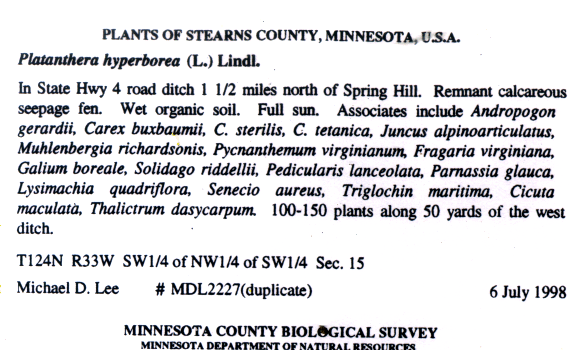
 |
Plant Taxonomy (BIOL308) - Stephen G. Saupe, Ph.D.; Biology Department, College of St. Benedict/St. John's University, Collegeville, MN 56321; ssaupe@csbsju.edu; http://www.employees.csbsju.edu/ssaupe/ |
Field Notebook and Label Preparation
Any herbarium specimen is only as good as its accompanying data
– without this information a specimen is virtually worthless. Therefore, it is
important to maintain complete and accurate records for each specimen that you collect.
The information will be recorded on herbarium labels that accompany each specimen. In
turn, the labels are prepared from the data recorded in your field notebook.
Field Notebook – Your field notebook should a convenient size (I use a
chemistry-style notebook) to carry into the field. It should also have a solid binding, in
other words, not be a loose-leaf style notebook. Waterproof notebooks are particularly
nice. Information that you should record in your field notebook includes:
The take-home-message: the more data the better!
If several specimens are going to collected at one site, record the location and other data (date, habitat, etc.) across the page. Then, as each plant is collected, assign it a number and record the individual data for that specimen. Repeat the process for each additional specimen collected at that site. Leave room in your notebook for the scientific name (if you don't know it) and for taking notes and making sketches as you identify the plant. When you switch locations, then a new line or two of general collection data is recorded followed by data for each individual specimen. If only a single specimen is collected at a particular site or on a particular day, then the entire entry for the specimen will include the location data, date, etc.
It is best to record specific information and observations concerning each specimen as it is collected and then pressed. However, this is not always possible. In this case, these data should be recorded as soon as possible – typically upon return to the lab or at day's end. If it is not possible to press your specimens immediately, they will keep for a day or two in a refrigerator.
For more information about field notebooks, visit the web site "Field Techniques Used by Missouri Botanical Garden". by R. Liesner at the Missouri Botanical Garden. This site is a vast wealth of information about collecting and preserving plants.
Field Notebook in Plant Taxonomy (Biol308) - In our course we will follow a slightly different version for a field notebook. We will not use a standard bound notebook as is typical for most plant taxonomists; rather, for each plant that you collect you will be required to complete a "Field Record Form." These will then be inserted into a three-ring binder as your "field notebook." The rationale for this approach is that it will help teach you the types of data to include in your notebook by providing a template of information to record.
Labels
– Herbarium labels should be prepared from the information recorded in your field notebook. The information that should appear on the label is the same as that required for the field notebook. An example of a good label follows. Note that this label provides: (a) the state, county and country where the specimen was collected (Stearns County, Minnesota, USA), (b) the precise geographic location where the specimen was collected (State Hwy 4, 1.5 miles north of Spring Hill) with the township, range and section; (c) the habitat in which the specimen was growing (roadside ditch, remnant calcareous seepage fen, organic soil, full sun); (d) the abundance; (e) associated species; (f) collector's name and number; (g) an indication that this is a duplicate specimen that was collected; (h) the date of collection; and (i) the collector's affiliation (MN County Biological Survey, DNR).

Reference:
Field Techniques Used by Missouri Botanical Garden" by R. Liesner, Missouri Botanical Garden
Guide to Collecting Plants for Museum Specimens - Anita Cholewa, University of Minnesota
|
| Top | Plant Tax. Home | SGS Home | Disclaimer | |
Last updated:
08/28/2007 / � Copyright by SG
Saupe